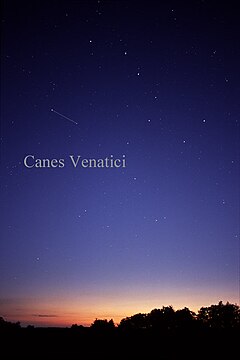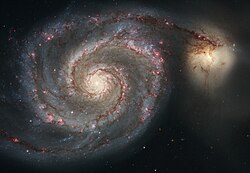Canes Venatici
Canes Venatici (the hunting dogs or greyhounds) is a small northern constellation introduced by Johannes Hevelius in the 17th century.
Notable features
The brightest star in the constellation, α Canum Venaticorum, is a binary star whose main component is a chemically peculiar star of spectral type A0VpSiEu —it shows an anomalous abundance of certain metals— prototype of a group of variables that bears its name. In addition, it has one of the strongest magnetic fields in a star, 2,000 times greater than that of Earth. The secondary component of the system is of the F2V type.
The next brightest star is β Canum Venaticorum, officially named Chara and also known as Asterion. It is a star very similar to our Sun and can be considered a solar twin: of spectral type G0V, its mass is 2% less than that of the Sun, while its diameter is only 2.5% greater.
The third brightest star is 24 Canum Venaticorum, a type A4V star with excess infrared emission indicating the existence of a circumstellar disk of dust and gas. It is followed in brightness by 20 Canum Venaticorum, a variable Delta Scuti of spectral type A9IImF2 that receives the name —in terms of variable— of AO Canum Venaticorum.
10 Canum Venaticorum is a yellow dwarf of type G0V about the same size as the Sun and shining with a luminosity 15% greater than solar luminosity. However, it has a very low metallicity (its relative abundance of iron equal to 30% of the solar one) so it is thought to be an ancient thick disk star.
Another notable star is Y Canum Venaticorum, known as La Superba, a carbon star with a spectacular red color. It owes its name to the astronomer Angelo Secchi who, impressed by its beauty, called it that ("the pride"). Its estimated radius is 5.1 AU, which would be practically equivalent to the size of Jupiter's orbit. Observations made by the IRAS satellite in the infrared have revealed that La Superba is surrounded by a dust layer of 0.9 parsecs in diameter.
In this constellation is found RS Canum Venaticorum, an archetypal eruptive variable of a class of close binaries whose components show intense chromospheric activity. BH Canum Venaticorum is another variable of this same class; among stars that are less than 50 parsecs from Earth, it is one of the brightest in the X-ray region. On the other hand, the AM Canum Venaticorum variables consist of a binary system in which a white dwarf accumulates hydrogen-poor matter from a compact star. The orbital period of these systems is extremely short; in the case of AM Canum Venaticorum —prototype of the group—, its period is just over 17 minutes.
WD 1401+457 is a DC-type white dwarf in Canes Venatici. With an effective temperature of only 2670 K and an estimated cooling time of nearly 12 billion years, it is the oldest white dwarf in the vicinity of the solar system.
Among the Canes Venatici Messier objects is M3, a globular cluster made up of around 500,000 stars with an estimated age of 11.4 billion years. Contains 274 known variable stars, including 133 RR Lyrae variables; is by far the largest number of variables in a globular cluster.
In addition, various galaxies can be observed in this constellation. M51, called the Whirlpool Galaxy, is a spiral galaxy that is interacting with NGC 5195. In the first, three supernovae have been observed: the last one, called SN 2011dh, was detected on May 31, 2011 and reached magnitude 12.1. Both galaxies are part of the M51 Group of galaxies and are approximately 23 million light-years from Earth.
Another member of this group is M63, occasionally known as the Sunflower Galaxy; It is a spiral galaxy located at a distance of approximately 30 million light years. Also in this constellation are located the galaxies M94 and M106. The first is a front-facing spiral galaxy with two rings, one inner and one outer; in the inner ring there is intense star formation activity. For its part, M106 contains an active nucleus and is classified as a Seyfert galaxy.
For its part, NGC 4214 is an irregular galaxy somewhat larger and brighter than the Small Magellanic Cloud distant 10 million light years. It has a number of young massive clusters—ranging in age from less than 2 million years to 20 million years—scattered along its bar, as well as some older massive clusters.
Main Stars
- α Canum Venaticorum (Cor Caroli). His name means "the heart of Charles", as a tribute to the English king Charles II (1630-1685), in which the Greenwich Observatory was founded. It is a very visible double star; one of its components, α2 Canum Venaticorum, is the prototype of a class of variables that carry its name (Alpha2 Canum Venaticorum variables).
- β Canum Venaticorum (Asterion or Chara), with magnitude 4,26, second brightest star of the constellation whose physical characteristics are very similar to the Sun.
- 5 Canum Venaticorum, yellow giant of magnitude 4,77. It's a barium star.
- 6 Canum Venaticorum, also yellow giant, but of magnitude 5.01.
- 10 Canum Venaticorum, yellow dwarf of magnitude 6,00 which is characterized by its low metallicity.
- 24 Canum Venaticorum, white star of the main sequence of magnitude 4,70 where a circum-stellar dust disc has been detected.
- R Canum Venaticorum, red and variable giant Look whose magnitude varies between 6.5 and 12.9 in a cycle of 328.5 days.
- And Canum Venaticorum (La Superba), a carbon star and semi-regular variable of a spectacular red color. With a temperature of 2800 K, it is one of the coldest stars that exist.
- RS Canum Venaticorum, prototype of a class of variable stars bearing its name (variables RS Canum Venaticorum) and also eclipsing binary.
- AM Canum Venaticorum, a very blue star of magnitude 14, prototype of a class of cataclysmic binaries.
- AO Canum Venaticorum (20 CVn), fourth brightest star of the constellation with magnitude 4.73 and variable Delta Scuti.
- AW Canum Venaticorum, orange and semi-regular variable whose magnitude fluctuates between 4.72 and 4.81.
- BH Canum Venaticorum, eruptive variable of the type RS Canum Venaticorum of mean magnitude 4,93; its main component is an Am star.
- BI Canum Venaticorum, contact binary and variable W Ursae Majoris.
- BK Canum Venaticorum (21 CVn), variable Alfa2 Canum Venaticorum de magnitid 5,15.
- DD Canum Venaticorum, variable Gamma Doradus of magnitude 7,14.
- DT Canum Venaticorum, star Lambda Bootis of magnitude 5.89.
- Gliese 507.1 (GJ 9440), red dwarf of magnitude 10.66.
- Gliese 521, also red dwarf of magnitude 10.26.
Deep Sky Objects
- M51 (Galaxia Remolino). AR: 13h 29m 54.0s Dec: +47°12'00" (Epoca 2000). Its distance to the Sun is 15 million light years and has a companion NGC 5195 AR: 13h 30m 00.0s Dec: +47°16'00" (Epoca 2000).
- M63 (Sunflower Galaxy). AR: 13h 15m 48.0s Dec: +42°02'00" (Epoca 2000) - M94 (NGC 4736) AR: 12h 50m 54.0s Dec: +41°07'00" (Epoca 2000) and M106 (NGC 4258) AR: 12h 19m 00.0s Dec: +47°18'00" (Epoca 2000). Spiral Galaxys can be observed with small telescopes.
- M3 (NGC 5272). AR: 13h 42m 12.0s Dec: +28°23'00" (Epoca 2000). Bright globular cluster.
- NGC 4214. AR:12h 15m 39.2s Dec: +36°19'37" (Epoch 2000). Irregular Galaxy, currently suffering from a star outbreak.
- NGC 4244. AR: 12h 17m 30.0s Dec: +37°49'00" (Epoca 2000). Spiral Galaxy, 8th west of Cor Caroli, not far from the previous one.
- NGC 4449. AR: 12h 28m 11.1s Dec: +44°45'37" (Epoca 2000). Irregular Galaxy also experiencing a stellar outbreak.
- NGC 4485. AR: 12h 30m 30.0s Dec: +41°42'00" (Epoca 2000) and NGC 4490 AR: 12h 30m 36.0s Dec: +41°38'00" (Epoca 2000). Two galaxies observed in the same field at 4485 are called Cocoon Galaxy, 4490 is larger and brighter. They are located 1st northeast of Beta Canum Venaticorum.
- NGC 4631. AR: 12h 42m 06.0s Dec: +32°32'00" (Epoca 2000). Very bright, 6th south of Cor Caroli and 2nd west. In the same field there are two galaxies plus NGC 4656 AR: 12h 44m 00.0s Dec: +32°10'00" (Epoca 2000) and NGC 4657 AR: 12h 44m 12.0s Dec: +32°12'00" (Epoca 2000).
Mythology
They represent Asterion and Chara, the two dogs supported by the Mountain Dog keeping the path of the bears around the north pole.
Additional bibliography
- Allen, Richard Hinckley (1963, 1899). Star Names: Their lore and meaning (in English). New York, NY: Dover Publications. ISBN 0-486-21079-0.
- Apianus, Petrus (1533). Horoscopen generale (in Latin).
- Bečvář, Antonín (1951). Atlas Coeli (II – Catalogue 1950.0 edition). Czechoslovak Astronomical Society.
- Hevelius, Johannes (1690). Firmamentum Sobiescianum (in Latin).
- Kunitzsch, P. (1959). Arabische Sternnamen in Europe (in German). Otto Harassowitz.
- Ptolomeo, Claudio; translator Kunitzsch, P. (1974). Der Almagest: Die Syntaxis Mathematica des Claudius Ptolemäus in arabisch-lateinischer bulberlieferung. Otto Harassowitz.
- Ridpath, Ian; Tirion, Wil (2017), Guide to Stars and Planets (5th edition), Princeton University Press, ISBN 9780691177885.
- Kunitzsch, P. (1990). Der Sternkatalog des Almagest die arabisch-mittelalterliche Tradition (in German). II Die lateinische Motorstorbersetzung Gerhards von Cremona. Otto Harassowitz.
Contenido relacionado
Van Allen Belts
Carina
(8308) Julie-Mélissa






